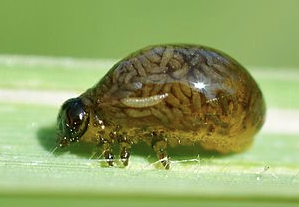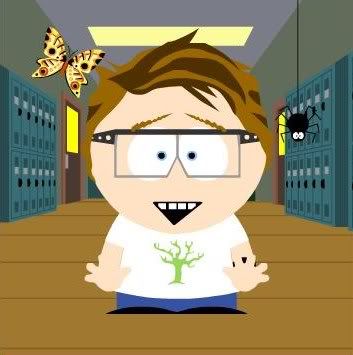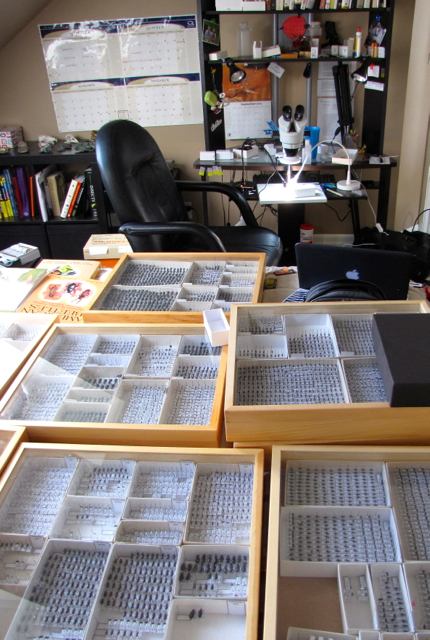So a very cool bug photo has been circulating on the web: I’ve seen it on Tumblr, Facebook, Pinterest and Twitter. It’s a pretty darn great photo:

Photo of a Cereal Leaf Beetle Larva, by Giles San Martin, used under a Creative Commons License.
Let’s zoom in on that a little, shall we?

Well, my goodness. That’s really something, isn’t it? Here’s the accompanying story circulating on the web:
This is a juvenile form of the Cereal leaf beetle (Oulema melanopus) after being parasitized by Tetrastichus julis, a parasitoid wasp which lays its eggs inside the larva of the beetle. They eggs hatch within the larvae and begin to feed while it is still alive, before they burst out and kill it.These parasites are often used as a biological control, as the Cereal leaf beetle is considered a pest and regularly feeds on crops.
Well, now, that is REALLY something isn’t it? Parasites are so freaking cool.
The problem is, the pairing of this particular image with this particular caption has lead to some confusion.
While the species identities are correct, and the stated relationship between the two is correct, the caption seems to imply that the skin of the poor beetle larva is stretched shiny-tight and close to bursting from a insanely huge parasite load (indeed, this is how the interwebz has been interpreting it).
This interpretation is only a little bit correct.
The beetle IS parasitized – by one parasite. Just one.
The rest of that squirmy-looking mass on the back of the beetle is a perfectly normal thing (well, if you’re a leaf beetle anyways): it’s a fecal shield. Yes, fecal shield. As in, “poop”.
Many, many Chrysomelids (leaf beetles) create fecal shields, depositing their feces on their backs. It’s so prevalent, in fact, that the study of fecal shields warrants its own term, apparently. From the section in Caroline Chaboo’s book chapter on Chrysomelid defences entitled, “Fececology” (ha!):
The [Chrysomelid] subfamily Cassidinae has ~3,000 species whose larvae carry a mobile shield made of dried feces, attached to paired processes at their hind end, and held over the body like an umbrella. This shield may be held flat on the dorsum or elevated to hit an attacker. In two other leaf beetle subgroups, the subfamily Criocerinae (~1,400 species) and in some members of the subfamily Galerucinae (~14,000 species) the fecal material is simply piled directly onto the back of the animals, with some falling off as the animal moves around but regularly replenished to maintain coverage of the exposed dorsal surface (Fig. 2b, c). In Chrysomelinae leaf beetles (~4,000 species), the mothers take time to build a fecal case entirely around every single egg.
Compare the photo above with this one showing the fecal shield of a Criocerine Chrysomelid, Lilioceris lilii:

Photo by Luis Sanchez, used under a Creative Commons License.
Also goey, revolting, and arguably very unsanitary – but normal.
Here’s a different spin on the same theme, this time in a tortoise beetle larva (Cassidinae):
Less slimy, and mobile – but normal. (And still poop).
Fecal shields provide camouflage, prevent desiccation (drying out), and, ironically, can deter predators and parasitoids. Some parasitoids, however, can exploit the fecal sheild and may actually be attracted to the plant volatiles (smelly plant chemicals) in the feces. This could be what happens in the relationship shown in the photo, since the T. julis is a well-established predator of the cereal leaf beetle and, obviously, that goey shield is not much of a deterrent.
So, just to clarify what you’re seeing in the original ZOMGPARASITES photo: in addition to piles of poop, the one visible parasitoid larva is the pale, segmented critter in the front near the beetle larva’s head. Now, its placement is a little odd, because T. julis is normally an endoparasitoid, meaning that the mother wasp lays her egg(s) directly inside the body of the host (the beetle larva). In this case, though, it looks like the parasitoid larva is floating in the fecal shield, so I’m not sure what that’s all about. Lousy aim, perhaps? Even if it was a motherly misfire, I have it on good authority (hat tip to Richard Comont) that the photographer reared out the parasitoid and it did indeed grow up to be T. julis.
So. Long story short:
This is a normal fecal shield, people. Not an imminent explosion.
__________________________

Chaboo, Caroline (2011). Defensive Behaviors in Leaf Beetles: From the Unusual to the Weird in Chemical Biology of the Tropics, J.M. Vivanco and T. Weir (eds.), 59-69 DOI: 10.1007/978-3-642-19080-3_4
Evans, E., Karren, J., & Israelsen, C. (2006). Interactions Over Time Between Cereal Leaf Beetle (Coleoptera: Chrysomelidae) and Larval Parasitoid Tetrastichus julis (Hymenoptera: Eulophidae) in Utah Journal of Economic Entomology, 99 (6), 1967-1973 DOI: 10.1603/0022-0493-99.6.1967
Schaffner, U., & Müller, C. (2001). Exploitation of the Fecal Shield of the Lily Leaf Beetle, Lilioceris lilii (Coleoptera: Chrysomelidae), by the Specialist Parasitoid Lemophagus pulcher (Hymenoptera: Ichneumonidae) Journal of Insect Behavior, 14 (6), 739-757 DOI: 10.1023/A:1013085316606



















